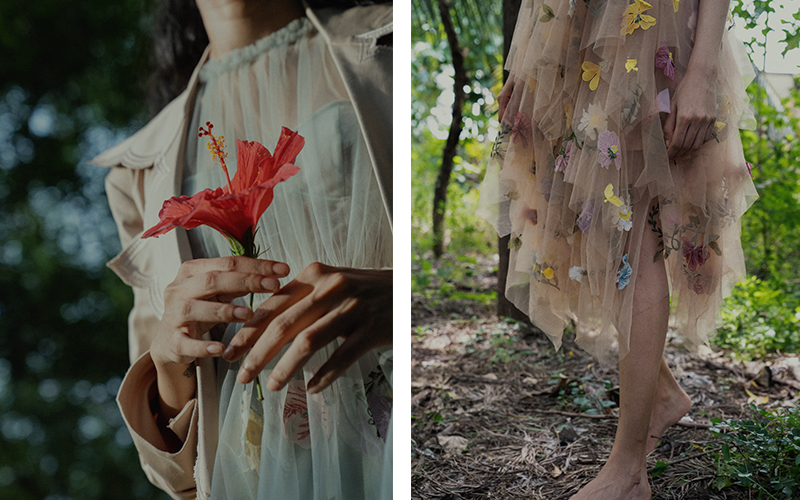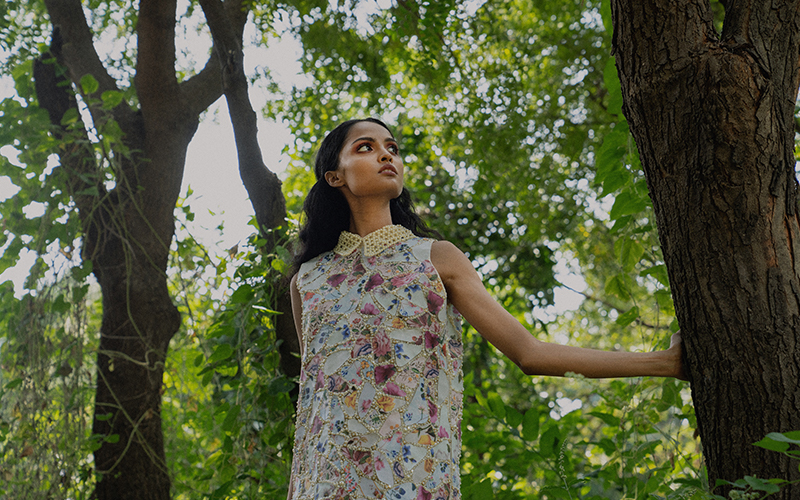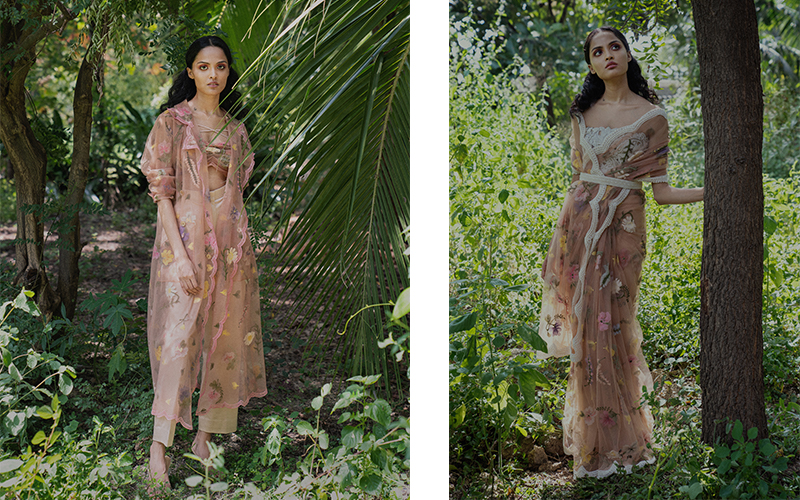Archana Rao SS21 line is about conscious living and high thinking, in a world that has realised the importance of de-cluttering
By Asmita Aggarwal
With an air of despondency overtaking every sphere of our lives, many feel it has given them time to step back and reflect on how they want to take their brand forward. Hyderabad-based Archana Rao wanted to be mindful in every stage of creation, from designing to production, to marketing and branding.
This is how the moodboard for this collection was created; there is a lot of focus on reduce, reuse and recycle. As a brand, weve always incorporated classic silhouettes with embroideries and design details to elevate the looks. We want to create a collection that can stand the test of time. Our inspiration for this line, was on spiritual and personal growth, and the looks have been designed to showcase this concept, she admits.
Her SS21 Collection, Do you suppose shes a wildflower? was created in part to promote slow fashion, and is designed using the principles of re-cycle and up-cycle. All the tulle pieces in this collection are designed using left over fabrics and the embroidered pressed flowers are created using scraps of fabrics in different colours.

We want to work in and contribute towards creating a world that is respectful and awed by nature in its entirety. To create designs that make people happy and practices that have a positive impact in the world. The change needs to begin at home; we need to reflect on our past choices to build a stronger brand, with repurpose and sustainability being the prime focus, she says.
Fashion needs to slow the pace, now more than ever. The hope for the future is responsible living. The process began when Archana was de-cluttering her home in the lockdown, and she realised that over time she has purchased a lot of items that she didn’t necessarily need. I found clothes I never wore, shoes that don’t fit me, knick knacks stored away in boxes. I decided, I want to live a clutter-free life, with only necessities that have immediate use for me. I think what we need more is sensible necessities as opposed to impulsive buying. What we wear, who we speak to, what we spend on, it is all going to be meaningful and people will look forward to being truly content. The future is going to be emotionally gratifying for everyone by choice, she says.
This is also what she tried to portray in the fashion film. We wanted our film to convey a feeling of acceptance, of being at peace with who you are. In the end, it’s about becoming your own person, who is happy with who she is. It’s not about reaching the finish line or ticking everything from a checklist; if youre happy with yourself midway, then thats your finish line, she says.
The line focuses on introspection and spiritual growth; to know yourself, to acknowledge your vulnerabilities and limitations, and to learn to be at peace with who you are. The idea is to show personal growth, and the collection reflects the same. We explore a variety of silhouettes and embroideries to showcase each phase of growth. Romantic tulle ruffle skirts, elegant tea length dresses with a corset, khaki trench coats with scallop detail and boiler suits with a scatter of pressed flowers. Subtle yet strong details like pearl collar and hand-embroidered leather cut outs. A new detailing explored in this collection is broken china mosaic print on leather interspersed with pearl detailing, she says.

As a brand, the maximum engagement takes place online. They use social media as a tool to help us gauge feedback on the outfits and collections. Its a great way to communicate with audiences from across the country and world. We also receive regular customer queries directly on our email, or through our website and E-commerce is the need of the hour, now more than ever. Our Shop page is in the works, and I cant wait for everyone to experience it, she says.
Her signature remains classics with a twist. Archana likes experimenting with techniques on classic silhouettes, such as a white shirt with 3D petal embroidery or a flapper dress with glass bead embroidery. The brands aesthetic is balanced between structure and feminine sophistication; featuring intricate embroideries and trimmings on a myriad of surface techniques.
We aim to create realistic wearable garments built to stand outside trends and time. The focus is on making separates and to leave the ultimate decision of styling to the end customer. Its always interesting to see what people make of my clothing and how they bring in a little bit of their personality every time they style my pieces, she says.
Buyers have become more aware and mindful of where we spend our money, and how we can contribute to a greener future. Before the pandemic, she would receive queries from customers who wanted to know where and how their clothes are going to be made. But people have become more informed during the pandemic and are asking all the right questions. Our goal for the brand this year was zero wastage and to work on a collection to promote slow fashion, designed using the principles of re-cycle and up-cycle. Im extremely happy that we did that and showcasing this collection at LMIFW this season. We have classic silhouettes and subtle yet impactful detailing that elevates every outfit. There are classic shirts with embroidered sleeves, embroidered bustiers that can be paired with saris, worn over shirts and dresses, or can be paired with trousers or skirts. Trench coats, elegant dresses, skirts and boiler suits; this collection has something for everyone and can be worn during the day or for a night out, she says.

The start of the lockdown was a bit tough, but social media and online orders kept the brand going. There were client appointments over video call and orders over the phone. We are extremely thankful to our loyal customers who have always supported us. My main concern during this time was the well being of my employees, especially our karigars and tailors, who are the backbone of the industry and have been with us since we started the label, she admits.
It was during this time that 14 designers came together in the hope to raise funds to support embroiderers, tailors and artists; in collaboration with NGO Sneha, who work with victims of domestic violence. The Saving the Artist initiative was created during the Covid-19 pandemic to help the unsung heroes of fashion, who keep our industry vibrant and flourishing, she says.
She aims to incorporate sustainable and greener practices in every stage of production, and have been a part of various causes and collaborations to promote sustainable fashion. In 2019, Archana contributed and curated Hyderabads first clothes swap event, Switcheroo with a view to promote sustainable fashion in the city.
We have collaborated with multi-disciplinary artist collective Dabaki for a project involving a journey to the Nilgiris. As a part of the project, we created wooden hand bags in collaboration with the Toda Artisans. Toda embroidery from the Nilgiris is made exclusively by hand and unique to the region. We created a collection of bags that combined this traditional craft with modern elements in terms of design and construction; with a view to keep and protect and promote the hard work of the artisans, she adds.

She believes functionality and fantasy can go hand-in-hand. She has always been a fan of mixing structure with a bit of whimsy and its something that you will find in most of her collections. Structured blazers with botanical embroideries and lace inserts, white shirt with 3D floral embroidery and organza scalloped sleeves, corset jumpsuit with sugar bead embroidery. At the end of the day, its about creating designs that you believe in, because when you put your heart and soul into anything, the end result will always be satisfying. Creative fulfillment in my work leads to some great designs, which invariably appeals to the customers, she admits.
Digital is not only an increasingly important sales channel; it can fuel innovative ways of customer acquisition, and create a system that enables transparency. I do miss the physical show and the endless emotions it brings with it. The entire process of a Fashion Week; from meeting the LMIFW Team in person, to model fitting sessions, meeting buyers, stylists and editors and walking them through our collection, greeting our clients personally and the feeling of being present in the moment are priceless. The exhilaration we feel after watching the beautiful shows and meeting all the other designers, seeing all the amazing clothes theyve created is something Ill miss the most. But, now the health and safety of customers and employees, remain the absolute priority. Digital medium has helped launch genuine, purpose driven communications. I believe that its the right time to strengthen the business for an omni-channel, digital centred next normal, she adds.
The health and well being of employees and customers have been a top priority for Archana. The fashion industry has repeatedly proven its ability to reinvent itself and adjust to where, what and how consumers buy. As a whole, we need to lead with compassion. Consumers are taking a closer look into the brands that they mean to buy from, and theyre asking more questions, there is a shift from fast-fashion. The situation is a wakeup call for designers and entrepreneurs to realise the slow planning process of a sustainable business model, she concludes.

